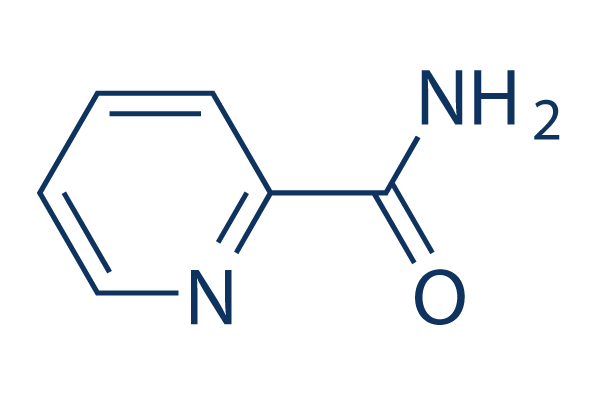Picolinamide (2-Pyridinecarboxamide, Picolinoylamide, 2-Carbamoylpyridine) is found to be a strong inhibitor of poly (ADP-ribose) synthetase of nuclei from rat pancreatic islet cells. In a prior investigation, picolinamide was employed to assess the potential correlation between the inhibition of NAD hydrolyzing enzymes and the inhibition of Na+/phosphate cotransport. The inhibition of Na+/phosphate cotransport by isolated renal brush border membrane vesicles was demonstrated by the results of an overnight picolinamide treatment of rats.
Physicochemical Properties
| Molecular Formula | C6H6N2O | |
| Molecular Weight | 122.12 | |
| Exact Mass | 122.048 | |
| CAS # | 1452-77-3 | |
| Related CAS # |
|
|
| PubChem CID | 15070 | |
| Appearance | White to off-white solid powder | |
| Density | 1.2±0.1 g/cm3 | |
| Boiling Point | 257.7±32.0 °C at 760 mmHg | |
| Melting Point | 110 °C (dec.)(lit.) | |
| Flash Point | 109.7±25.1 °C | |
| Vapour Pressure | 0.0±0.6 mmHg at 25°C | |
| Index of Refraction | 1.590 | |
| LogP | -0.24 | |
| Hydrogen Bond Donor Count | 1 | |
| Hydrogen Bond Acceptor Count | 2 | |
| Rotatable Bond Count | 1 | |
| Heavy Atom Count | 9 | |
| Complexity | 114 | |
| Defined Atom Stereocenter Count | 0 | |
| InChi Key | IBBMAWULFFBRKK-UHFFFAOYSA-N | |
| InChi Code | InChI=1S/C6H6N2O/c7-6(9)5-3-1-2-4-8-5/h1-4H,(H2,7,9) | |
| Chemical Name | pyridine-2-carboxamide | |
| Synonyms |
|
|
| HS Tariff Code | 2934.99.9001 | |
| Storage |
Powder-20°C 3 years 4°C 2 years In solvent -80°C 6 months -20°C 1 month |
|
| Shipping Condition | Room temperature (This product is stable at ambient temperature for a few days during ordinary shipping and time spent in Customs) |
Biological Activity
| Targets | PARP ( IC50 = 95 μM ) | ||
| ln Vitro |
|
||
| ln Vivo |
|
||
| Cell Assay | It has been determined how a Gram-negative rod oxidizes picolinamide. The findings demonstrated that whole cells could release 2,5-dihydroxypyridine into culture supernatants at high pH levels. Furthermore, whole cells were able to accumulate 6-hydroxypicolinate in the culture media as a result of sodium arsenite. Furthermore, it was discovered that picolinamide oxidizes instantly in whole cells. Additionally, it was discovered that cell-free extracts were capable of hydroxylating picolinate into 6-hydroxypicolinate and converting picolinamide into picolinate. | ||
| Animal Protocol |
|
||
| References |
[1]. Specific inhibition of rat renal Na+/phosphate cotransport by picolinamide. J Pharmacol Exp Ther. 1989 Oct;251(1):188-92. [2]. Protection by superoxide dismutase, catalase, and poly(ADP-ribose) synthetase inhibitors against alloxan- and streptozotocin-induced islet DNA strand breaks and against the inhibition of proinsulin synthesis. J Biol Chem. 1982 Jun 10;257(11):6084-8. [3]. Protection by picolinamide, a novel inhibitor of poly (ADP-ribose) synthetase, against both streptozotocin-induced depression of proinsulin synthesis and reduction of NAD content in pancreatic islets. Biochem Biophys Res Commun. 1980 Jul 16;95(1):474-81. [4]. Induction of rat pancreatic B-cell tumors by the combined administration of streptozotocin or alloxan and poly(adenosine diphosphate ribose) synthetase inhibitors. Cancer Res. 1985 Apr;45(4):1845-9. |
||
| Additional Infomation | Picolinamide is a pyridinecarboxamide that is the monocarboxylic acid amide derivative of picolinic acid. It is functionally related to a picolinic acid. |
Solubility Data
| Solubility (In Vitro) |
|
|||
| Solubility (In Vivo) |
Solubility in Formulation 1: ≥ 2.5 mg/mL (20.47 mM) (saturation unknown) in 10% DMSO + 40% PEG300 + 5% Tween80 + 45% Saline (add these co-solvents sequentially from left to right, and one by one), clear solution. For example, if 1 mL of working solution is to be prepared, you can add 100 μL of 25.0 mg/mL clear DMSO stock solution to 400 μL PEG300 and mix evenly; then add 50 μL Tween-80 to the above solution and mix evenly; then add 450 μL normal saline to adjust the volume to 1 mL. Preparation of saline: Dissolve 0.9 g of sodium chloride in 100 mL ddH₂ O to obtain a clear solution. Solubility in Formulation 2: ≥ 2.5 mg/mL (20.47 mM) (saturation unknown) in 10% DMSO + 90% (20% SBE-β-CD in Saline) (add these co-solvents sequentially from left to right, and one by one), clear solution. For example, if 1 mL of working solution is to be prepared, you can add 100 μL of 25.0 mg/mL clear DMSO stock solution to 900 μL of 20% SBE-β-CD physiological saline solution and mix evenly. Preparation of 20% SBE-β-CD in Saline (4°C,1 week): Dissolve 2 g SBE-β-CD in 10 mL saline to obtain a clear solution. Solubility in Formulation 3: ≥ 2.5 mg/mL (20.47 mM) (saturation unknown) in 10% DMSO + 90% Corn Oil (add these co-solvents sequentially from left to right, and one by one), clear solution. For example, if 1 mL of working solution is to be prepared, you can add 100 μL of 25.0 mg/mL clear DMSO stock solution to 900 μL of corn oil and mix evenly. (Please use freshly prepared in vivo formulations for optimal results.) |
| Preparing Stock Solutions | 1 mg | 5 mg | 10 mg | |
| 1 mM | 8.1887 mL | 40.9433 mL | 81.8867 mL | |
| 5 mM | 1.6377 mL | 8.1887 mL | 16.3773 mL | |
| 10 mM | 0.8189 mL | 4.0943 mL | 8.1887 mL |
